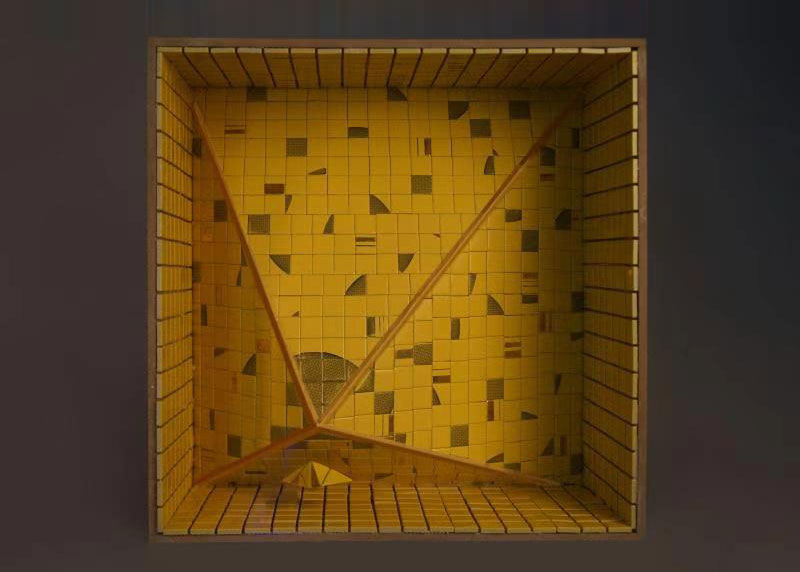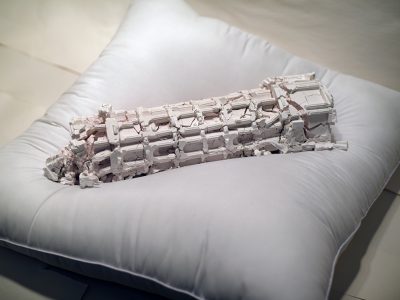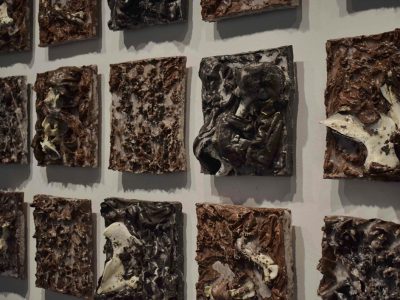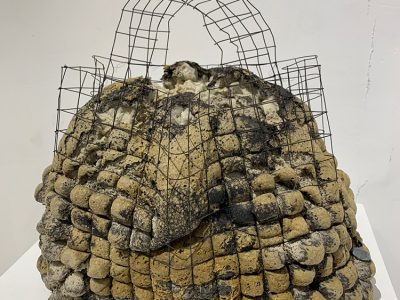Exhibition
NEITHER INCREASING
NOR DECREASING
无增无减
Virtual exhibition pairing Chinese ceramists
with objects from Chiddingstone Castle’s Buddhist Collection
本次虚拟展览将由中国陶艺家挑选出奇丁斯顿堡的佛教收藏品配对再创作
31 August – 31 October 2021
Chiddingstone Castle & online
Chiddingstone Castle
in partnership with The Ceramic House
Neither Increasing Nor Decreasing is part of INTERBEING, an exploration of collaborative ceramic and sound art practice in Britain and China taking place throughout 2021, curated by Kay Aplin & Joseph Young of The Ceramic House, Brighton, UK.
Inter-being is a Buddhist concept that comes from the Heart Sutra and, in the context of INTERBEING, explores the cultural connections between two seemingly very different cultures, the UK and China. By starting from a point of similarity rather than distance, the project aims to foster and encourage a deeper understanding between countries.
Chiddingstone Castle, in collaboration with The Ceramic House, hosts a virtual exhibition, pairing art works by Chinese ceramic artists with objects from the castle’s Buddhist Collection. The collaboration came out of a research trip in 2019 by the Interbeing project curators Kay Aplin & Joseph Young, following a visit to Shanghai Academy of Fine Art where they met Guanghui Chen, Head of Ceramics. The selected artists represent some of China’s leading ceramic artists as well as emerging artists, all of whom are renowned for innovative, ground-breaking work.
In the context of the ongoing global pandemic, a virtual exhibition opens up opportunities for continuing cultural exchange and collaboration made otherwise impossible by an inability to travel in person. Audiences are able to visit the museum in person to view the objects from the Buddhist collection and remotely view the Chinese artworks on their smartphones. Online viewers will be able to access the exhibition via The Ceramic House website.
“无增-无减”是一个陶瓷和声音艺术合作探索项目,该项目是英国和中国艺术家在2021年实施的一个“互即互;INTERBEING”项目的一部分,由英国布莱顿陶瓷中心的凯•阿普琳女士和约瑟夫•杨先生共同策划。
“互即互”取自佛教中的互生概念,源自《心经》,在互生的背景下,“互即互”探讨了英国和中国两种看似截然不同的文化之间的联系。通过寻求双方相似点的关联而非物理距离的隔断,该项目旨在促进和鼓励国家间更深入的理解。
将中国陶瓷艺术家的作品与奇丁斯顿堡博物馆的佛教藏品配对而进行的虚拟展览,是奇丁斯顿堡与布莱顿陶瓷中心的一个合作项目。这项项目源自“互即互”项目策展人凯•阿普琳和约瑟夫•杨2019年对中国当代陶瓷的一次探索之旅,他们访问了上海美术学院,并在那里会见了陶瓷负责人陈光辉先生。这次入选的艺术家是中国先锋陶艺家以及新兴艺术家的代表,他们都以创新和突破性的作品而闻名。
在新冠疫情在全球持续蔓延的背景下,虚拟展览为那些因不能旅行而无法进行的文化交流与合作提供了机会。观众可以线下参观博物馆,观看佛教藏品,同时通过智能手机链接中国艺术家与一些特定藏品的互动作品;而线上观众则可以通过布莱顿陶瓷中心网站访问“无增-无减”展览项目。
To accompany the exhibition, Joseph Young presents a short series of field recordings from Guangdong Province made on a research trip to China in March-April 2019 when The Ceramic House curators travelled around China meeting potential partners for the Interbeing project.
ARTISTS
The artists selected by Shanghai Academy of Fine Art represent some of China’s leading ceramic artists as well as some newer, emerging artists all of whom are renowned for innovative, ground-breaking work.
YANZE JIANG 蒋颜泽
QI JI 祁吉
XU XINHUA 徐鑫桦
LI MENGYUN 李梦云
HONGBO XU 徐洪波
LU BIN 陆斌
CHEN GUANGHUI 陈光辉
KANG QING 康青
HUANG HUANYI 黄焕义
RONG SHENG 戎盛 谢艺
ZHOU XIAN-FENG 周先锋
01.1612
BRONZE BUDDHA, MING DYNASTY 铜佛像,明代
YANZE JIANG 蒋颜泽

01.1612
Buddha, seated in dhyanasana (medita 4 on posture) on a lotus base, with his hands in bhumis – parsamudra (touching-earth gesture), lacquered bronze. China, Ming Dynasty (16th – 17th cen – tury). Height: 29cm
01.1539
TWENTY-FOUR ARMED AVALOKITESHVARA 二十四臂观音像
QI JI 祁吉

01.1539
Twenty-four armed Avalokitesvara, bodhisattva of compassion, seated in dhyanasana (medita- 4on posture), with his main pair of hands in anjalimudra (prayer gesture). His elongated upper- most hands hold a seated Buddha. Sino-Tibetan, 17th – 18th century. Height: 46cm, Length: 25cm, Width: 12cm
01.1497
GHANTA (BELL) 犍稚钟
XU XINHUA 徐鑫桦

01.1497
Ghanta (bell), bronze with inscrip4on. Tibet, 18th century. Height: 19.5cm, Width: 9cm
01.1494
HANDHELD PRAYER WHEEL WITH A HORN HANDLE
牛角把手转经轮
LI MENGYUN 李梦云

01.1494
Handheld prayer wheel with a horn handle, bronze drum inlaid with stones. Tibet, 19th century.
Height: 26cm, Width: 6cm
01.1516
GA-U (CHARM BOX) 噶乌
HONGBO XU 徐洪波

01.1516
Ga-u (charm box), silver with gilt bronze and inlaid with turquoise and a ruby. The ga-u was a Mongolian charm or reliquary box that was used to enshrine Buddhist images. Tibet. Height: 10cm, Length: 8cm
01.1590
STUPA佛塔
LU BIN 陆斌

01.1590
Stupa (monument which holds relics of the Buddha), gilt bronze containing a painted image of the Buddha. Tibet, 18th century. Height: 17.5cm, Width: 11cm
01.1495
VAJRA 金刚杵
CHEN GUANGHUI 陈光辉
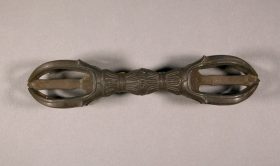
01.1495
Vajra (diamond-bolt sceptre), bronze. Tibet, 19th century. Length: 13.5cm
01.2942
THANGKA 唐卡
KANG QING 康青

01.2942
Thangka (temple wall hanging), painted cotton with a silk brocade mount. The thangka depicts Padmasambhava, one of the first teachers of Buddhism in Tibet, holding a staff, seated on a lotus throne, and surrounded by other deities. Tibet, 18th century.
01.1533
EWER 水壶
HUANG HUANYI 黄焕义
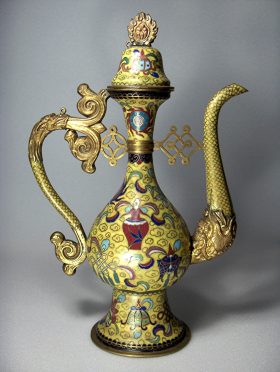
01.1533
Ewer, cloisonné enamel on gilt bronze. China, Qing Dynasty (19th century). Height: 27cm
01.1595
AVALOKITESHVARA 观世音菩萨
RONG SHENG 戎盛 谢艺

01.1595
Avalokitesvara, bodhisaMva of compassion, gilt bronze. Avalokitesvara is standing on a lotus base, with both hands in vitarkamudra (teaching or deba4ng gesture). Sino-Tibetan, 17th – 18th century. Height: 16.5cm, Length: 7cm
01.1582
BUDDHIST PLAQUE
佛牌
ZHOU XIAN-FENG 周先锋

01.1582
Buddhist plaque, bronze, on a modern stand. The plaque depicts a seated Buddha on one side and Chinese text in relief on the other. China. Height: 13cm
PHOTOGRAPHS from the digital opening on insta live
ARTISTS
In Motion
by Jacques Kaufmann
(Dis) Orientations
With Covid 19 acting as a catalyst, and with global warming which sees people resisting the actions that are required to face its inescapable reality, we are now faced with our interdependencies and our colossal collective fragilities, in a state of major disorientation.
This pandemic has revealed, accelerated, imposed, credited virtuality as a fundamental modality of the contemporary world, magically supposed to respond to the challenges of time. Pandemic and global warming give rise to a feeling of “Solastalgia“1. We have, in fact, entered a hazy “after world”, in which the Interbeingproject is looking for a way forward.
The Buddhist Collection at Chiddingstone Castle
by Naomi Collick, Curator at Chiddingstone Castle
Chiddingstone Castle was the home of the art dealer and collector Denys Eyre Bower (1905 – 1977). He moved into the Castle in 1955 with his eclectic and impressive collections of Buddhist, Stuart and Jacobite, Japanese, and Ancient Egyptian artefacts.
The collections were the work of a lifetime and were inspired by Denys’ experiences or personal interests. He started his career as a bank clerk in his small home town of Crich in Derbyshire. He bought the Castle after pursuing his dream of running a successful antiquities dealership in London. He moved in, filled every spare space with his collections, and opened it up to the public for visitors to view for a small entrance fee. He gave the tours himself and wrote labels by hand for some of the objects, leaving the rest to be appreciated for their visual qualities.
Inter-being is a Buddhist concept that comes from the Heart Sutra and, in the context of INTERBEING, explores the cultural connections between two seemingly very different cultures, the UK and China. By starting from a point of similarity rather than distance, the project aims to foster and encourage a deeper understanding between countries.
Sign up for our newsletter at the bottom of this page to hear about the latest news.

Neither Increasing Nor Decreasing is part of the Interbeing project – an exploration of collaborative ceramic and sound art practice in Britain and China. Throughout 2021 at The Ceramic House.





